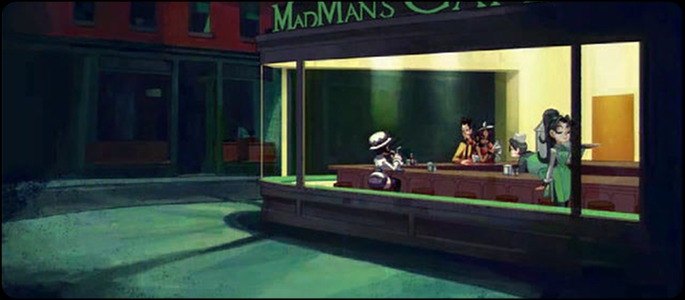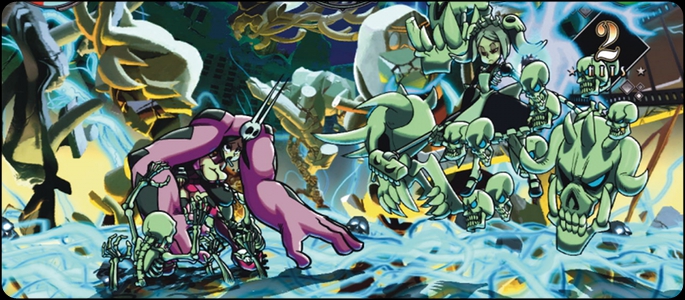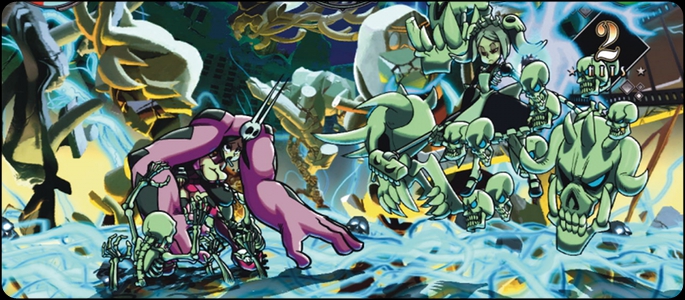
Within the last couple of years, the fighting game genre has been privy to a revitalization and has gone on to see a significant surge in interest from both experienced fighting game players as well as amateurs eager to learn more. But despite the spike in the number of new players coming to the genre, the big developers responsible for forming the basis of its origins have largely remained the same. Just the phrase ‘fighting game genre’ is enough to conjure images of Capcom, NetherRealm Studios, SNK, or Arc System Works. So it’s rare when a completely original fighting game IP takes center stage and is created by a lesser known or even entirely new developer. But that’s currently where we find ourselves with the release of Reverge Labs’ debut title Skullgirls.
Skullgirls is a 2D anime fighting game that takes place within a world known as the Canopy Kingdom, which has a distinct style that is an anime take on art deco. Within this realm, a special artifact known as the Skull Heart is sought after by adventurers for its ability to grant a wish to those that find it. Unfortunately, if a person with an impure soul makes a wish, the artifact will grant their desire, but turn them into an all powerful being known as the Skullgirl hellbent on destroying humanity. The game’s story mode is comprised of eight self contained vignettes that follow each of the individual female characters in different plot lines complete with still image cutscenes and dialog. The game also has an arcade mode which will pit the player against randomly generated opponents. At the end of any of the story campaigns or the arcade mode the player faces off against the titular Skullgirl. But Skullgirls, like many other fighting games, is not able to overcome the cheesiness of this premise. Fortunately, the main draw of Skullgirls is how it plays rather than the story wrapped around it.
In terms of the actual fighting, Skullgirls borrows mechanics from various other games within the genre. Outside of the story mode, players have the option to play as a single fighter, a pair, or in a team of three. At first this idea may sound odd in that both players make this choice individually, but the game does a fantastic job of scaling both the damage and health depending on the choice made. So, as a single fighter players that dislike the Marvel vs. Capcom school of fighting can opt for a very powerful main fighter at the expense of calling in assist attacks or being able to tag in another fighter. Meanwhile, a player opting for a triplet will find that they have more versatility in terms of comboing from one character into another and having access to multiple fighters for any situation. However, each individual does less damage and has less health.

Additionally, players opting for this approach can configure and customize the assist attacks to anything desired. While this could potentially be a huge way in which to exploit the game, Reverge Labs has implemented an infinite breaker system in order to prevent such abuse. Simply put, when an infinite loop is detected the game will allow the player being pummeled to instantly break out of the loop. So while there are no combo breakers (in the Mortal Kombat or Killer Instinct sense of the phrase) the prevention of infinites through this system gives players creative license to go nuts. The decision of which team setup to go with is a matter of personal preference, but can have a major impact on strategies employed. Giving players a choice in the matter adds a great layer of depth to the fighting system.
In terms of controls, combos are relatively easy to pull off with either a DualShock 3 or a joystick. In my case, I used my second generation Hit Box arcade stick. A stick does seem ideal for Skullgirls as the game has a light, medium, and heavy setup to the controls. As such, a six button arcade stick will work fine given the button combinations needed to pull off specials and supers. Of course, I should mention that the latency and input speed of some joysticks can be a problem as there are times where the game had trouble recognizing specific button inputs when I was pressing too quickly. However, this is more of a problem between the integration of the Hit Box’s hardware with the software that is Skullgirls. Still, traditional joysticks should have no trouble working with Skullgirls and the game also offers players options with respect to reconfiguring controls if necessary.

Another major aspect of Skullgirls is the tutorial system. The tutorials within the game go to a level of depth previously unseen within the genre. Have you ever wondered what a ‘hit-confirmation’ is? Do you know how to ‘poke’ your opponent? Are you upset because you don’t know what a ‘cancel’ is? Can you defend against a ‘hi-lo mix-up’ in order open your opponent up for a ‘punish’? Like many of you scratching their heads at the previous questions, I didn’t know what many of these terms actually were until I played through the robust tutorials within Skullgirls. In fact, I actually played through all the tutorials first and as a result the normal experience of button mashing my way through the opening hours of a fighting game were replaced by bread and butter combos comprised of normals (that’s what they call punches and kicks) in a ‘magic series’ (a combo made up of normals strung together).
Most of the tutorials will take a few tries, with the last three in particular taking a larger chunk of time. However, practice does make perfect and getting through the tutorials not only gives a player a deeper understanding of the mechanics at work within this game, but also many other fighting games within the genre. It’s a fantastic way to make the game more accessible to new players without sacrificing difficulty for those who may be more familiar with fighting game principles.

The online suite of options is pretty standard and features GGPO netcode integration, much like Street Fighter 3: Third Strike Online. Before each match, the game will detect your ping and recommend a GGPO delay setting for a match. Setting the delay appropriately ensures that ranked fights happen in smooth, lag free fashion. It is a bit weird that the game doesn’t simply set the delay for you once it determines what the optimal setting should be, but this is a minor complaint that does nothing to really mar the online experience. Players can also create unranked rooms in order to just duke it out, but when I tried to join some unranked rooms during my time with the game I didn’t find any in operation. This is probably due to the fact that the quick match option (which pits players in a ranked mode fight) connects very fast and finds appropriately skilled opponents quickly.
Skullgirls also features a nicely rendered anime art style which, while developed by a western studio rather than a Japanese one, is fluid and distinct enough to stand with the best. Each character has a unique look and feel that also feeds directly into how they play. As an example, Peacock is a robot that has several cartoony projectile attacks which make her very good at zoning and locking down an opponent. Ms. Fortune is more of a rushdown/pressure character that can use her head as a weapon to hot box an opponent making it easier to land high damage combos. This is also complimented by a awesome jazz soundtrack produced by Michiru Yamane, who some may remember was the composer for Konami’s Castlevania series including Castlevania: Symphony of the Night for the PS1. There are also some unique bits of dialog if certain combinations of characters square off against each other before the start of the round. As an example, if Valentine and Peacock square off Valentine will say “It’s time for your check up!” before Peacock exclaims in an Animaniacs inspired voice “Hellooo nurse!”

Reverge Labs has done some pretty innovative things with Skullgirls but there are some problems that are just too large to ignore. The first problem is that there’s only an 8 character roster which increases the potential for mirror matching. This probability goes up when triplet team setups are also taken into account. Reverge Labs has already stated that they will be adding in more DLC characters (including some male characters) in the future provided that the game sells well. Also, the game doesn’t feature movelists in-game. The solution to this problem is to go to the game’s website and download a PDF which features all of the movelists. It’s not the best solution to this problem, but again Reverge has stated that they will patch the game and include movelists at a later date.
The end boss battle of the single player modes in the game is also ridiculously tough. While Skullgirls is not the first game to throw an absurd boss battle at the player (and it probably won’t be the last), the Skullgirl battle at the end of the arcade or story modes is very cheap even on the lower difficulties. Finally, the character designs are hypersexualized, a problem that is only exacerbated by the fact that all of the characters are female. This is the opposite direction that the fighting game community is trying to go these days in the wake of the Cross Assault/Wednesday Night Fights sexual harassment controversy. Indeed this is partially mitigated by the fiercely independent nature of the characters, but it’s difficult to view the game that way when Valentine’s celebratory animation is sticking a thermometer between her boobs, and most of the characters are dressed in skintight outfits.

Normally, contradictions are considered bad, but Skullgirls has some contradictions within it that are actually innovative in practice. It’s a western developed game steeped in Japanese influences both artistically and mechanically. The game maintains an adequate level of difficulty while at the same time having a robust tutorial structure that allows new players to learn the basics as well as advanced moves inherent to this game and others within the genre. Unfortunately, there are a few flaws that will make some players hesitant to pick this up, but, for $14.99, Skullgirls is as complete as any retail fighting game package. So if you have some friends to play with locally or a decent internet connection, Skullgirls is definitely worth a look. It’s a fun fighter that will keep dedicated players practicing special-to-super cancels and air dashes for months to come while attracting new players to the genre. Let’s hope that Reverge builds upon some of the great ideas on display here and that the larger community of fighting game developers take a cue from Reverge Labs’ tutorial structure. Indeed, we live in exciting times for the fighting game genre and here’s hoping it only gets better.
PlayStation LifeStyle’s Final Score
+ GGPO netcode produces a smooth online experience. + Excellent art deco anime style and kicking sound track. |
 |
–




